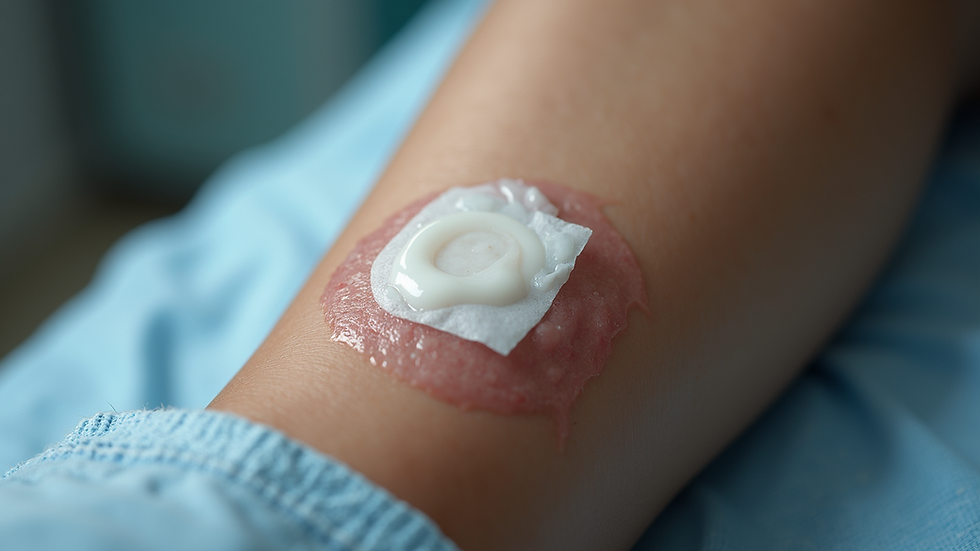Effective Wound Care Management Strategies
- Don Gentry
- Oct 15
- 3 min read
When you’re dealing with a wound, whether it’s a small cut or a chronic sore, proper care is essential. Taking the right steps can speed healing, reduce pain, and prevent infection. I want to share some practical strategies that can help you manage wounds effectively. These tips are designed to be clear and easy to follow, so you can feel confident in your care routine.
Understanding the Basics of Improving Wound Care
Before diving into specific techniques, it’s important to understand what good wound care looks like. The goal is to create an environment where your body can heal naturally. This means keeping the wound clean, moist, and protected from further injury.
Here are some key points to keep in mind:
Clean the wound gently: Use mild soap and water or a saline solution. Avoid harsh chemicals that can damage tissue.
Keep the wound moist: Moisture helps new cells grow and prevents scabs from forming too early.
Protect the wound: Use appropriate dressings to shield the area from dirt and bacteria.
Monitor for signs of infection: Redness, swelling, increased pain, or discharge may indicate a problem.
By focusing on these basics, you set the stage for faster and safer healing.

Practical Tips for Improving Wound Care at Home
Managing wounds at home can feel overwhelming, but with the right approach, it becomes manageable. Here are some actionable recommendations you can follow:
Gather your supplies: Have clean gauze, adhesive bandages, saline solution, and antibiotic ointment ready.
Wash your hands thoroughly before touching the wound or changing dressings.
Clean the wound gently with saline or mild soap and water. Pat dry with a clean cloth.
Apply a thin layer of antibiotic ointment if recommended by your healthcare provider.
Cover the wound with a sterile dressing that keeps it moist but allows air circulation.
Change the dressing daily or whenever it becomes wet or dirty.
Avoid picking at scabs or peeling skin, as this can delay healing.
Keep the wound elevated if possible to reduce swelling.
Stay hydrated and eat a balanced diet rich in vitamins C and A, zinc, and protein to support healing.
Remember, if you notice any signs of infection or if the wound isn’t improving, seek medical advice promptly.

What is the nursing management of wounds?
Nursing management plays a crucial role in wound healing, especially for patients with chronic or complex wounds. Nurses assess the wound regularly, clean it properly, and select the best dressing to promote healing. They also educate patients and caregivers on how to care for wounds at home.
Some nursing strategies include:
Assessment: Measuring wound size, depth, and appearance to track progress.
Debridement: Removing dead tissue to prevent infection and encourage new growth.
Moisture balance: Using dressings that maintain the right level of moisture.
Pain management: Administering medications or using techniques to reduce discomfort.
Infection control: Applying antibiotics and maintaining hygiene.
Patient education: Teaching proper wound care techniques and lifestyle adjustments.
This comprehensive approach helps ensure wounds heal efficiently and complications are minimized.

How to Prevent Wound Complications
Preventing complications is just as important as treating the wound itself. Here are some ways you can reduce the risk of problems:
Keep the wound clean and dry when not applying dressings.
Avoid tight clothing or shoes that can irritate the wound.
Manage underlying conditions like diabetes or poor circulation, which can slow healing.
Avoid smoking and excessive alcohol, as they impair the body’s ability to repair tissue.
Stay active but protect the wound from excessive movement or pressure.
Follow your healthcare provider’s instructions carefully.
By taking these precautions, you help your body heal without setbacks.
When to Seek Professional Help
Sometimes wounds need more than home care. You should contact a healthcare professional if you notice:
Increased redness, swelling, or warmth around the wound.
Pus or foul-smelling discharge.
Fever or chills.
Wound edges that are pulling apart.
Persistent pain that doesn’t improve.
No signs of healing after a week or worsening condition.
Early intervention can prevent serious infections and other complications. Remember, you’re not alone in this process. Professionals are there to support you every step of the way.
For more detailed guidance on wound care management, you can visit trusted resources that offer expert advice and support.
Embracing a Healing Mindset
Taking care of a wound can feel challenging, but it’s also an opportunity to nurture your body and mind. Patience and consistency are your allies. Celebrate small improvements and stay attentive to your body’s signals.
By following these effective strategies for improving wound care, you empower yourself to heal safely and comfortably. Remember, every step you take brings you closer to recovery.
Stay gentle with yourself and your wound. Healing is a journey, and you’re doing great.




Comments